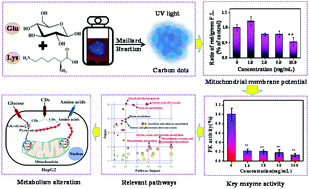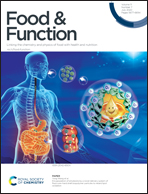The effects of carbon dots produced by the Maillard reaction on the HepG2 cell substance and energy metabolism†
Abstract
Endogenous nanoparticles produced during food processing have received considerable attention due to their unique physicochemical properties and potential safety risks. However, the bio-impact of endogenous nanoparticles on cell metabolism has not been fully studied. In this work, the effects of carbon dots (CDs) derived from the Maillard reaction of glucose and lysine on the cellular substance and energy metabolism were assessed using HepG2 cells as a model. When the HepG2 cells were incubated with 10.0 mg mL−1 of CDs, the mitochondrial membrane potential decreased significantly and the mitochondrial function was affected. The extracellular acidification rate and oxygen consumption rate were decreased in comparison to normal cells without CDs. The CDs blocked the glycolysis pathway by reducing the activities of key enzymes including phosphofructokinase and pyruvate kinase. The energy supply pathway of HepG2 cells changed from glycolysis to TCA cycle, but the increase of the TCA cycle flux could not meet the requirements for restoring cell proliferation. The increase of the compensatory flux in the TCA cycle may be the result of up-regulation of the metabolism of glucogenic amino acids and ketogenic amino acids, while lipid metabolism did not seem to be affected in this process.



 Please wait while we load your content...
Please wait while we load your content...